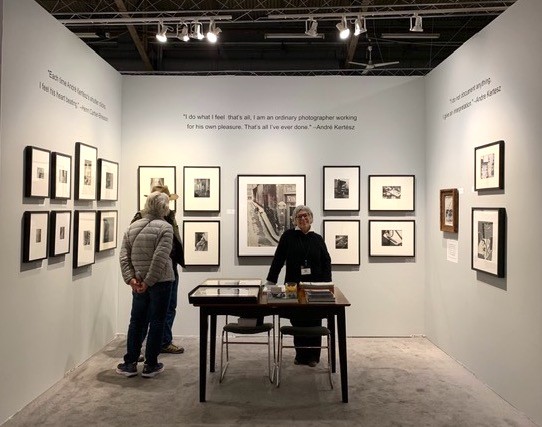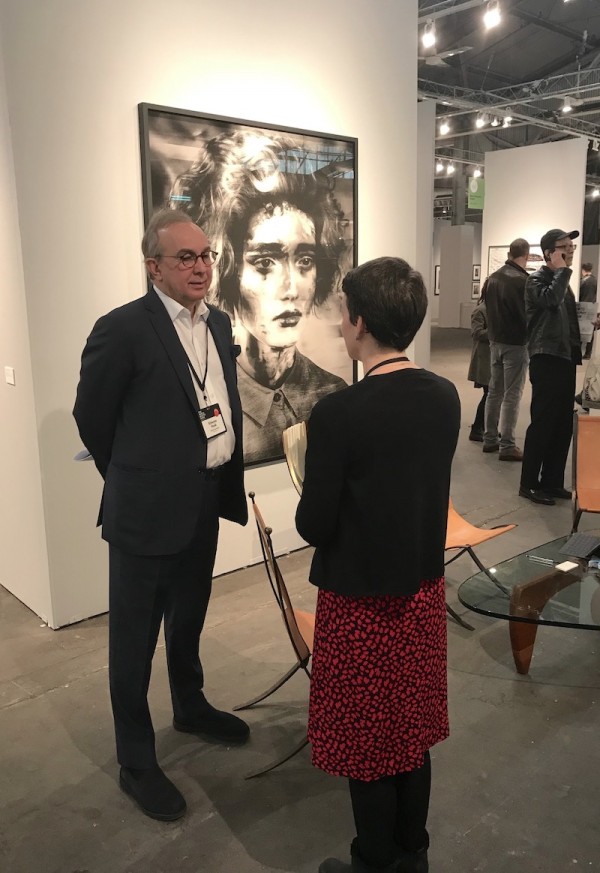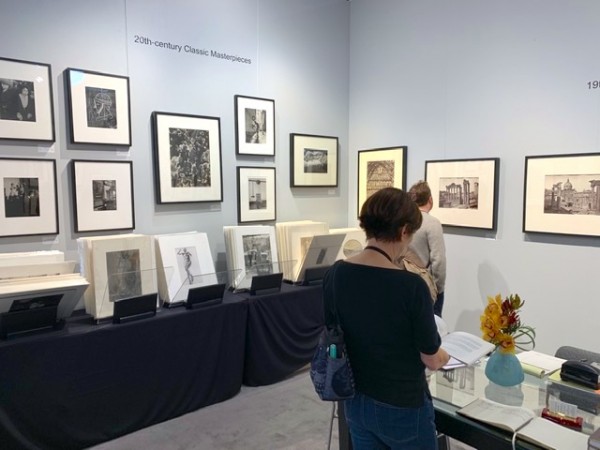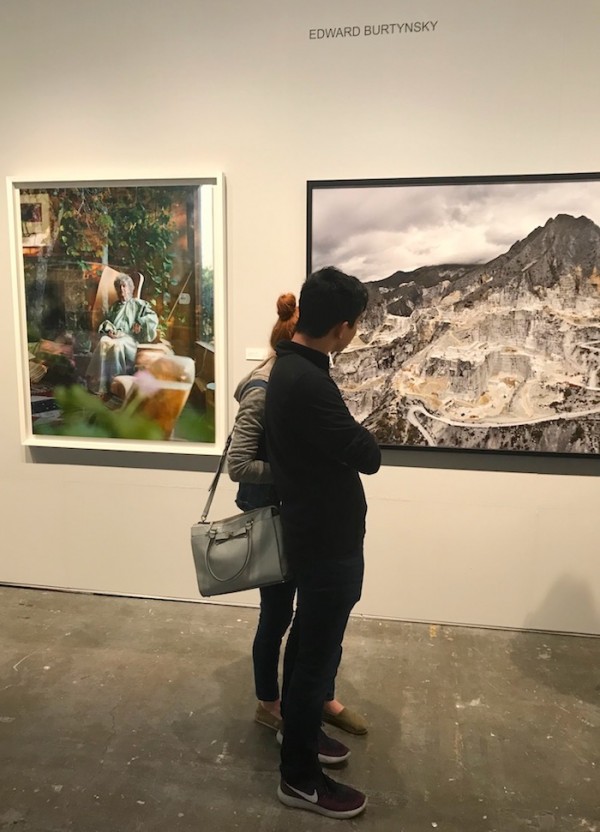Photography's Language of Light at a Record-Setting AIPAD NY Show 2019
Hope for Changes in Instagram's Heavy-Handed Censorship
Photo London Announces a New Director to "Help Unlock Strategic Potential"
Photo Review's Annual Garden Party June 15th in Easton, PA
Man Ray's Tomb Desecrated
Photo and Art Dealer Virginia Zabriskie Dies at 91 after a Long Illness
Artist Michael Wolf Dies in Hong Kong at Age 64
California Photo Dealer Louis Klaitman Passes away from Heart Congestion
CCP Director Gets New Dual Focus; and CCP Adds New Museum Deputy Director
New Approach to Eliminating Silver Mirroring on Developed-Out Silver Prints Reported

Photo: Kristina Nazarevskaia, GalleryIntell © The Photography Show
"Photography is my only language," Andre Kertesz once declared, as he helped bring the medium into the modern era--and by now its language of light transformed into multimedia artistry is the conversational currency at AIPAD's New York Photography Show. The 39th annual edition crowned a fine spring weekend from April 4 through 7 at Manhattan's vast Pier 94 exhibition space, with both attendance (more than 16,000 vs. 15,000 last year) increased and enthusiasm up on the part of the 94 fine art photography galleries who signed on. The good feeling was more than wishful--by the end of opening Wednesday, AIPAD had turnstiled more than 2,000 visitors, the most ever on a first day.
AIPAD Talks, which featured prominent curators, collectors, artists, and journalists, were very well attended. Speakers included Vince Aletti, Harry Benson, Dawoud Bey, Chris Boot, Malcolm Daniel, Sarah Greenough, Deana Lawson, Sarah Hermanson Meister, Corey Keller, An-My Lê, Stephen Shore, Rosalind Solomon, Carol Squiers, and Martha Wilson, among many others.
A number of celebrities and notables attended AIPAD including Frances McDormand, Joel Coen, Brenda Vaccaro, Harry Benson, Stephen Shore, Maggie Taylor, Dawoud Bey, Alec Soth, Deana Lawson, Richard Learoyd, Jeff Mermelstein, Martha Wilson, Stephen Wilkes, Elliott Erwitt, Tony Vaccaro, Gary and Sarah Wolkowitz, Joe Baio, Michael Mattis and Judith Hochberg, David Dechman, Celso Gonzalez-Falla, Vince Aletti, Sarah Hermanson Meister, Corey Keller, Brian Wallis, Malcolm Daniel, Lisa Hostetler, Keith Davis, Hans Rooseboom, Mattie Boom, Christine Symchych, Lisa Sutcliffe, Sarah Kennel, Clément Chéroux, Sarah Greenough, Sarah Hermanson Meister, Qiang Gao, Arthur Tress, and Jeff Rosenheim.
The Photography Show is known for its excellent attendance from museum curators. A few of the institutions represented included the Museum of Modern Art, New York; Metropolitan Museum of Art; International Center of Photography, New York; Morgan Library & Museum; Nelson-Atkins Museum of Art; Brooklyn Museum; Museum of the City of New York; George Eastman Museum; Philadelphia Museum of Art; San Francisco Museum of Modern Art; Museum of Fine Arts, Houston; Museum of Fine Arts, Boston; Carnegie Museum of Art; New Orleans Museum of Art; High Museum of Art; Milwaukee Art Museum; National Gallery of Art, Washington DC; and Rijksmuseum.

Hans Kraus, Jr. presents the AIPAD award to Sarah Greenough of the National Gallery of Art in Washington, DC. (Photo by Alex Novak © I Photo Central, LLC)
The AIPAD Award, established in 2017 to recognize visionaries who have spent their lives at the forefront of the field of photography, was awarded to Sarah Greenough, senior curator and head of the department of photographs at the National Gallery of Art in Washington, DC.
AXA Art continued as the premier sponsor for the show. AXA ART is part of AXA XL, a division of AXA. AXA XL Art & Lifestyle provides insurance for artworks, collectables, and high value items for the world’s most renowned institutions, collectors, and private clients.
The notably more museum-like atmosphere of last year's show--with special exhibition space added to the maze of dealer booths--was broadened out this year, with a newly curated section of project spaces for solo artists and focused theme exhibitions (offered not only to AIPAD members but to non-members of the organizing body, the Association of International Photography Art Dealers). The booths could be purchased aa solo exhibition space or in addition to the regular booth space taken. It did get a bit confusing at times because of this.
Dealer and Show Committee member Stephen Daiter said, "I think the project booths are a good thing for AIPAD, allowing some who couldn't mount a full booth this year and some non-members to show."

One of the project booth spaces devoted to master photographer André Kertész. (Photo by Alex Novak © I Photo Central, LLC)
The project booths (essentially, smaller-sized showcases) might have benefitted though from a bit more signage or show-based promotion that made clear their unique status this year. Nonetheless the concept marks the determination of AIPAD to reach beyond the parochialism of being of, by and for member dealers; and, at the same time allowed exhibitors to experiment with a single focus or artist, which might normally be financially prohibitive with a full booth.
In addition, the large section for photography book publishers continued to be a highlight unto itself–a first-rate specialty book fair with a fascinating program of artists being interviewed about their books, while overhead projections of the work allowed viewers to browse along, page by page.
This year's singular special exhibit (cut back from three last year) was "A Room for Solace: An Exhibition of Domestic Interiors", curated by photographer Alec Soth. Its theme was the possibility of finding refuge during turbulent times. Soth gathered portraiture, still life, and reportage from galleries exhibiting at the Show, and the result was as much a metaphysical as a physical representation of refuge. From Walker Evans's 1959 image of "Mary Frank's Bedroom" to Osamu James Nagawa's 2019 spectral exposure of an old man in a wheelchair behind a light-flooded curtain, as well as Sally Mann's 1991 image of her nude daughter posed on the tabletop of Mann's mother's house--a temporarily safe space for Mann's controversial portraiture--the exhibit suggested that refuge was as much a state of mind as of place, especially at a time when the world's migrant surges are so embattled.
Pushing Timely Buttons
If anything, the show's typical blend of vintage, modern and contemporary work seemed to push timely buttons wherever one looked. At New York's Edwynn Houk booth, Lynn Davis's dramatic 2007 image of an Iceberg on the verge of calving, as climate change wears on, was as much an editorial as a landscape study, while the moss-drenched trees of another Sally Mann image ("Deep South," from 1998) emphasized earth's timeless beauty.

Edwynn Houk in his booth chatting with his associate Julie Castellano. (Photo by Matt Damsker © I Photo Central, LLC)
Female photographers were strongly featured at the show and at Houk's space, which included examples of Diane Arbus and Imogen Cunningham, and Houk was upbeat about the response in general. "It's been terrific," he said. "Everybody was shocked at the crowd on opening night, with lines down the block to get in! Attendance has been up, and the whole thing has felt very energetic." The 2,000 who attended day one was AIPAD's most for a first day.
In another focus on women artists, L. Parker Stephenson Photographs, New York, introduced the work of Jane E. Atwood, an American photographer living in Paris, to strong sales and a great response from museum curators and private collectors.
The time-traveling energy (and metaphor) of the medium was very much in evidence at Alex Novak's Vintage Works/Contemporary Works booth, out of Chalfont, PA, with walls heralding the great beginnings of photography in the 1850s, with an atmospheric print of Gustave Le Gray's 1856 seascape classic "The Brig," as well as such early works as Bisson Jeune's 1858 depictions of ancient Roman ruins, such as the Temple of Jupiter--all the way to the modern pinnacle of Cartier-Bresson's delight-inducing 1953 shot of French schoolchildren from the top of Notre Dame cathedral. On the contemporary side of things, Novak offered the dazzling invention of Lisa Holden's multimedia color explorations. In addition, the special projects section proved a good way to expand Novak's vintage reach, through a solo show of André Kertész prints, spanning the great photographer's pioneering of photojournalism, and his international scope.

The booth for Contemporary Works/Vintage Works. (Photo by Alex Novak © I Photo Central, LLC)
"There's always a lot of interest in the inventors, not only of the medium, but also of its milestones," Novak observed. "And this year there's an even broader age spectrum of people, and many of them want to learn about the images and photographers that set the art form in motion. This year our sales were mostly in rare 19th-century pieces and we sold over a dozen early classic works to collectors, museums and even other dealers. We also sold some 20th-century images, including a great Erwin Blumenfeld nude and two Alfred Cheney Johnston nudes. Two of the sales were to important new clients, so we were happy to begin a relationship with them. And we have further collector and institutional interest in several other images."
Indeed, Richard Moore's Oakland, CA gallery featured walls of classic Dorothea Lange photos from America's Depression-era Dustbowl--iconic images that have defined the onset of photography as both an art and an act of witness to social struggle ("The contemplation of things as they are," quoting Lange on the booth's wall). Moore, who is also the current President of AIPAD, noted that "everyone seems happy with the layout and with sales so far. Attendance is up and that's great, but there's a lot of curatorial interest also, with sales to collectors and institutions."
Monroe Gallery of Photography, Santa Fe, said they were “very happy” and sold about 20 prints and rearranged their booth several times. Likewise, Catherine Couturier Gallery, Houston, sold numerous photographs and re-hung the booth each day.
Lee Gallery, Winchester, MA, said the Show was “great” and sold work to institutions including a major New York City museum and was pleased with the strong attendance of museum curators. Atlas Gallery, London, sold work by Sam Haskins, Jimmy Nelson, and Chris Simpson.
Paul M. Hertzmann, San Francisco, was extremely happy with AIPAD and sold a print by Edward Weston and Eastern European photography including a work by Geza Perneczky, which was acquired by a major New York City museum.
Dollars and Sense
The hard-dollar question of sales is never beside the point, of course, for all of AIPAD's artistic value and the throngs of just-looking gallery-gazers. "It was our best AIPAD yet," the Yancey Richardson Gallery, of New York, reported, citing sales of some 20 photographs in the $18,000 to $36,000 range, including work by Mitch Epstein, Ori Gersht, Zanele Muholi, Larry Sultan, and Mickalene Thomas. Edwynn Houk reported sales ranging from $6,000 to $140,000, including Walker Evans, Mona Kuhn, Vera Lutter and Sally Mann. And the Laurence Miller Gallery of New York reported that AIPAD was "very well attended with many curators and collectors, both veterans and young couples." Among their sales were three vintage prints by Helen Levitt that went for a combined $100,000.
New York may dominate much of the real estate and mind share of AIPAD, but the international contingent is equally important in terms of global growth and expanding audiences for photography. Over 11 countries were represented in the show. Utópica, a gallery from São Paulo, Brazil, reported selling prints of South American artist ranging from $4,000 to $12,000: "AIPAD is always very good. We meet lots of customers and over the last three years that we have been exhibiting, we are finding that collectors are really getting to know us."
As a launching pad for galleries offering work that may otherwise go unseen in the big markets, AIPAD can be invaluable. For Arnika Dawkins, whose Atlanta, GA, gallery is new to AIPAD membership, "sales were strong, and we had great conversations." Dawkins also showcased the digital chromogenic prints of Jeanine Michna-Bales, whose series "Through Darkness to Light" has been shown at The Phillips Collection in Washington, DC, and chronicles sites along the slave path to freedom in the U.S., from South to North, via the Underground Railroad. "We want to focus on the African diaspora," Dawkins added. Thus, she also was showcasing Ervin A. Johnson's "#InHonor" series, which pays homage to lives lost through race-related violence, and Delphine Diallo, whose portraits include models wearing African-style masks made of braided hair extensions.
Dawoud Bey's Tender Night

Dawoud Bey's photographs at Stephen Daiter Gallery booth.
Of course, Michna-Bales' color work and research on the Underground Railroad echoes the acclaimed artistry of Dawoud Bey, whose new black-and-white series, "Night Coming Tenderly, Black", was featured for the first time in New York City at AIPAD at the booth of Chicago's Stephen Daiter Gallery. Bey, known for his expressive portraiture of people of color and the marginalized, has broken ground with his somber, night-toned series of landscapes that are also a visual reimagining of the movement of fugitive slaves through the final stages of the Underground Railroad. The work is currently on view at the Art Institute of Chicago and will be seen next year at the Whitney Museum of American Art in New York and the San Francisco Museum of Modern Art. (As the work was being hung, editions of Untitled #2 (Trees & Farmhouse), Untitled #12 (The Marsh) and Untitled #4 (Leaves and Porch) sold—the first two reportedly went for $20,000 each, the third for $30,000.)
"The great response to Dawoud Bey's photography, and to the talk that he gave here, justified my feeling that we needed a larger space than last year," said Daiter. "Sales are solid, equal parts contemporary work like Dawoud's, and vintage."
Bruce Silverstein, whose New York gallery, was a rich nexus, as usual, of contemporary photography and influential modernists (including work by Aaron Siskind, Rosalind Solomon and Marjan Teeuwen), commented: "The crowds, the curators, the tremendous interest shown in work like Mishka Henner's '18 Pumpjacks Pumping'"--stunningly geometric aerial views of oil rigs in vast fields – "proves that AIPAD is a great platform and should only be bigger. Look at the photo book section--why not, for example, make it the world's biggest platform for photography book dealers?"
As platforms go, Terry Etherton's Tucson, AZ gallery proved that the gritty documentary photography of Danny Lyon's "Bikeriders" and "Conversations with the Dead" series from the 1960s and '70s–portraits of life in Texas prisons and American biker culture–still resonate strongly with viewers and buyers, with reserve prices reportedly ranging from $16,000 to $25,000, and interest strong from museums for more Lyon.
Meanwhile, New York's Throckmorton Fine Art's director of photography, Norberto Rivera noted how Mexican photographer Graciela Iturbide's famous 1979 photo Nuestra señora de las iguanas/Our Lady of the Iguanas, Mexico, in which a woman poses for the camera with a crown crafted from living iguanas, was a highlight of the show. Reportedly, the gallery's three Nickolas Muray color photos of Frida Kahlo sold ahead of the preview for a combined $35,500.
Benson Icons and Double Takes

Edward Burtynsky's contemporary large-format color aerial views on exhibit at the Robert Koch Gallery booth. (Photo by Matt Damsker © I Photo Central, LLC)
And yet the international flair gathered, as usual, by New York's galleries was equally on view at European spaces. Galerie Frederic Got of Paris offered classic examples of popstar imagery by the legendary Scot photographer Harry Benson, who, at 89, sat for an elbow-room-only gallery talk during the peak of the show, reminding us of the artful approach he took to his kinetic shots of The Beatles, Rolling Stones, Jack Nicholson, Jimi Hendrix and others in their '60s and '70s heydays. And San Francisco's Robert Koch Gallery proved that West Coast dealer culture was just as much about European mastery, with prints by Josef Sudek, Frantisek Drtikol or Man Ray, alongside Edward Burtynsky's contemporary large-format color aerial views of quarries and man's methodical scarring of the earth.
For the pleasures of sheer photographic artifice and "meta" force, though, it was hard to beat the crowd-grabbing, large-scale work on display at Bryce Wolkowitz's New York gallery, where the remarkable craftsmanship of Jojakim Cortis and Adrian Sonderegger of Switzerland delivered wows. Cortis and Sonderegger's "Double Take" series is a meticulous recreation, in miniature, of iconic photography–produced with studio models, plaster, string, and paper–that reinvent our experience of such famed images as Ansel Adams's immortal Yosemite National Park shot of the moon and Half Dome, or Robert Capa's devastating photo of a soldier felled during the Spanish Civil War.
One can question whether the duo's artistry is more stunt than revelation–but their power to make us look again at what we've seen so many times before is a genuine power. Wolkowitz said, straightforwardly, that AIPAD 2019 was all about "really good sales and results," noting that the one-of-a-kind Cortis and Sonderegger photo of their Ansel Adams re-creation, priced at $37,000, had sold.
Without question, the much vaunted energy of AIPAD 2019 reflected many things–-the angst of the political moment in the U.S. and U.K. in particular and the wider world in general; the ferment and unleashed creativity of rising and established artists for whom photography is a building block and starting point for mixed-media expression; and the enduring power of vintage and classic modern work that shows us, from one generation to the next, how the medium's founders and early innovators saw the world and taught us to see it with fresh eyes, through time and space. AIPAD's future seems limited only by the imagination of its members, collectors and creators, an equation that seems valid on almost every front of human aspiration.
Matt Damsker is an author and critic, who has written about photography and the arts for the Los Angeles Times, Hartford Courant, Philadelphia Bulletin, Rolling Stone magazine and other publications. His book, "Rock Voices", was published in 1981 by St. Martin's Press. His essay in the book, "Marcus Doyle: Night Vision" was published in the fall of 2005.
He currently reviews books and exhibits for both the E-Photo Newsletter and U.S.A. Today.
Photography's Language of Light at a Record-Setting AIPAD NY Show 2019
Hope for Changes in Instagram's Heavy-Handed Censorship
Photo London Announces a New Director to "Help Unlock Strategic Potential"
Photo Review's Annual Garden Party June 15th in Easton, PA
Man Ray's Tomb Desecrated
Photo and Art Dealer Virginia Zabriskie Dies at 91 after a Long Illness
Artist Michael Wolf Dies in Hong Kong at Age 64
California Photo Dealer Louis Klaitman Passes away from Heart Congestion
CCP Director Gets New Dual Focus; and CCP Adds New Museum Deputy Director
New Approach to Eliminating Silver Mirroring on Developed-Out Silver Prints Reported


Share This